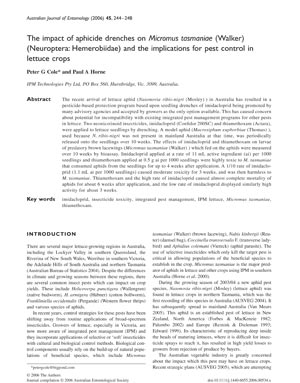|
|
The recent arrival of lettuce aphid – Nasonovia ribis-nigri (Mosley) – in Australia has resulted in a pesticide-based protection program based upon seedling drenches of imidacloprid being promoted by many advisory agencies and accepted by growers as the only option available. This has caused concern about potential for incompatibility with existing integrated pest management programs for other pests in lettuce. In this paper we have assessed the effect of the high rate of imidacloprid as a seedling drench on the predator M. tasmaniae (brown lacewing) and have compared it with a reduced rate (one tenth) of imidacloprid and with another neonicotinoid aphicide, thiamethoxam.
Australian lettuce crops host several common insect pests which can impact on crop yields. These include native budworm, cotton bollworm, Western flower thrips and various species of aphids. In recent years, control strategies for these pests have been shifting away from routine applications of broad-spectrum insecticides. Growers of lettuce, especially in Victoria, are now more aware of integrated pest management (IPM) and they incorporate applications of selective or ‘soft’ insecticides with cultural and biological control methods. Biological control components usually rely on the build-up of natural populations of beneficial species, which include Micromus tasmaniae (Walker) (brown lacewing), Nabis kinbergii (Reuter) (damsel bug), Coccinella transversalis F. (transverse ladybird) and Aphidius colemani (Viereck) (aphid parasite). The use of selective insecticides which only kill the target pest is critical in allowing populations of the beneficial species to establish in the crop. Micromus tasmaniae is the major predator of aphids in lettuce and other crops using IPM in southern Australia. During the growing season of 2003-04 a new aphid pest species, Nasonovia ribis-nigri (Mosley) or lettuce aphid, was found in lettuce crops in northern Tasmania and subsequently spread to mainland Australia. This aphid is an established pest of lettuce in New Zealand, North America and Europe. Its habit of reproducing deep inside the heads of maturing lettuces, shields it from routine insecticide tretaments. This has resulted in high yield losses to growers from rejection of produce by buyers. Strategic plans to combat the potential impact of this pest, have included the use of NR resistant lettuce varieties and increased rates of imidacloprid insecticide seedling drench. The drenching process involves overhead spraying of seedlings, just prior to planting, at a volume which saturates the seedling cells but without leaching. Imidacloprid is toxic to some beneficial arthropods although it can be used safely with some parasitoid species. The increase in the recommended rate may be detrimental to the establishment of beneficial species in lettuce crops where it is applied. Conclusions :
Acknowledgements : This work was funded by Horticulture Australia Limited and AUSVEG (the Australian Vegetable Grower’s Association). We would like to thank Janet Horne and Rhonda McBain for maintaining the insect colonies, and Jessica Page for her work on IPM dealing with lettuce aphid. |
|

